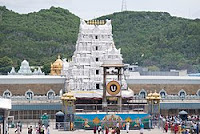Worlds most famous Vaishnavite shrine
Tirupati is a city in Chitoor district of the Indian State of Andra pradesh. The city is home to most famous and important Vaishnavite shrine of Tirumala Venkateswara Temple and other historical temples and is referred to as the "Spiritual Capital of Andhra Pradesh".[7] It is one of the seven Swayam vyaktha kshetras dedicated to Vishnu. Tirupati is a municipal corporation and the headquarters of Tirupati(urban) mandal, and of the Tirupati revenue division. As of 2011 census, it had a population of 287,588, making it the ninth in Andhra Pradesh. It is the seventh most urban agglomerated city in the state, with a population of 459,985. Tirupati is home to many educational institutions and universities. For the year 2012–13, India's Minister of Tourism named Tirupati as the "Best Heritage City” Tirupati has been selected as one of the hundred Indian cities to be developed as a smart city under Smart Cities Mission by Government of India.
Tirumala (Upper Tirupati) was an established centre of Vaishnavism around the 5th century A.D. The city became great Vaishnava centre during the time of Ramanujacharya in 11th Century, from where Srivaishnavism spread to other parts of Andhra Desa. Srikumar temples in Srikakulam district of Andhra Pradesh bears the inscription saying Tirupati Sri Vaishnava Raksha. Tirupati survived the Muslim invasions. During the early 1300s Muslim invasion of South India, the deity of Sri Ranganathaswamy Temple, Srirangam was brought to Tirupati for safekeeping. The temple town for most of the medieval era part of Vijayanagar Empire until the 17th century and its rulers contributed considerable resources and wealth notable by Krishnadevaraya and Achyuta dev Raya, Sadasiva Raya and Tirumala deva raya.
The temple was built and upgraded in parts by various kingdoms. The inscriptions in the temple were found in Kannada, Sanskrit, Tamil, Telugu languages which specify the contributions of the Pallava Kingdom around the 9th century AD, Chola Kingdom around the 10th century AD and the Vijayanagar Empire in the 14th century AD.[20] During the 15th century, Sri Tallapaka Annamachariya sung many songs in praise of the holy town in Telugu. He compared it to be divine, including the rocks, streams, trees, animals, and adds that it is heaven on the earth. One example of such a song is
Tirupati is located at 13.65°N 79.42°E in the Chittor District of South Indian State of Andra Pradesh. It lies at the foot of Seshadchalam Hills of Eastern ghats which were formed during Precambrain era. One of its suburbs, Tirumala, which is the home to Sri venkateshwara Temple, is also located within the hills.[25] Tirupati Urban agglomeration includes Tirupati (City) and census towns Akkarampalle, Avilala, Cherlopalle, Mangalam, Perur, Settipalle, Thummala gunta (part), Timminaidupalle, Tiruchanur, Tirupati (NMA).
Tirupati is surrounded by Srikalahasti towards the east, Puttur towards the south, Poothalapattu towards the west and the Seshachalam hills towards the north Swarnamukhi River originates in Chandragiri Hills and passes through the Tirupati City before reaching Srikalahasti in the east.
At 12 km point on the Tirupati – Tirumala ghat road, there is a major discontinuity of stratigraphic significance that represents a period of remarkable serenity in the geological history of the Earth. This is referred to as Eparchaean Unconformity . This unconformity separates the Proterozoic Nagari Quartzite and the Archean granite representing a time gap of 800 Ma. In 2001, the Geological Survey of India (GSI) declared the Eparchaean Unconfirmity to be one of the 26 "Geological Monuments of India".
Silathoranam(natural arch)) at Tirumala Hills, Tirupati, Andhra Pradesh
Silathoram, a natural arch and a distinctive geological feature, is located in the Tirumala Hills at a distance of 1 km from Tirumala Venkateshwara Temple. The Arch measures 8 metres in width and 3 metres in height and is eroded from quartzite of Cuddapah Supergroup of Middle to Upper Proterozoic (1600 to 570 Ma) by weathering agents like water and wind.
Flora and fauna
Sri Venkateswara National Park is a national park and biosphere reserve which is part of Seshachalam Hills. The total area of the park is 353 km2. The park is home for about 1,500 vascular plant species belonging to 174 families. Some of the rare and endemic plant species like red sander ,shorea, talura,shorea thumburggaia Terminalia pallid, sandalwood, Syzygium alternium, and Psilotum occur in this region. Cycas beddome, a species of cycad in the genus cycas, is found only in the thirumalai.
About 178 species of birds from this national park have been identified which includes the globally threatened Yellow throated bulbul,grey-fronted green pigeon, critically endangered Oriental white backed vulture,large hawk-cuckoo,blue-faced malkoha, yellow browed bulbul, Indian scimitar-blabbler and Loten’s sunbird. Among predators the leopard is quite common, along with the wild dog. Among reptiles, the most interesting species is the gliding lizard, found in some deep forested valleys. Another important reptile of this national park is the golden gecko.
Established in 1987, Tirupati Zoo or Sri venkateshwara Zoological park is a zoo located at Tirupati and is Asia's second largest zoo, with an area of 5500 acres. It is built on the concept of Hindhu mythology. It exhibits only animals that are mentioned in the ancient epics like Ramayana, Mahabharatha, and Panchatantra. The enclosures are named based on Indian mythology. It hosts a wide range of animals such as deer, monkeys, lions, tigers, bears, elephants, peafowl, grey pelicans, marsh crocodiles, and starred tortoises.





Comments
Post a Comment